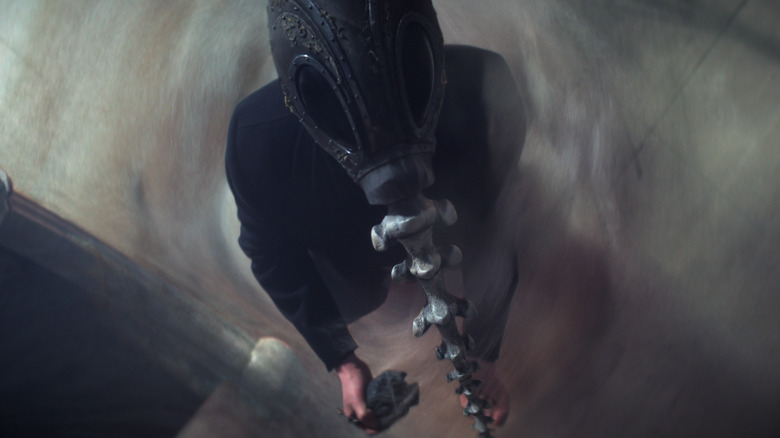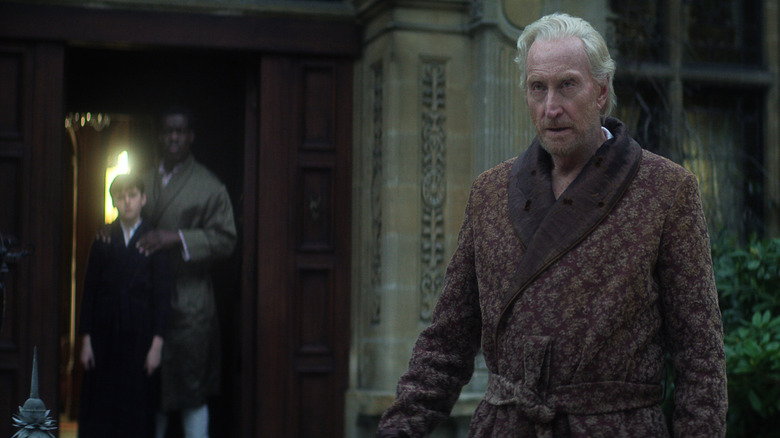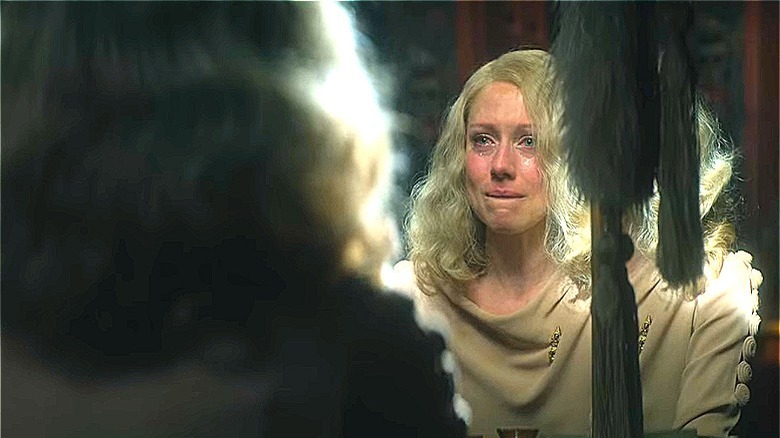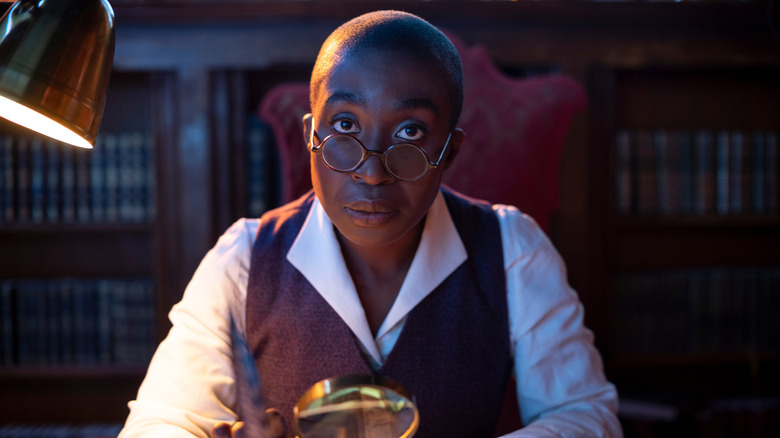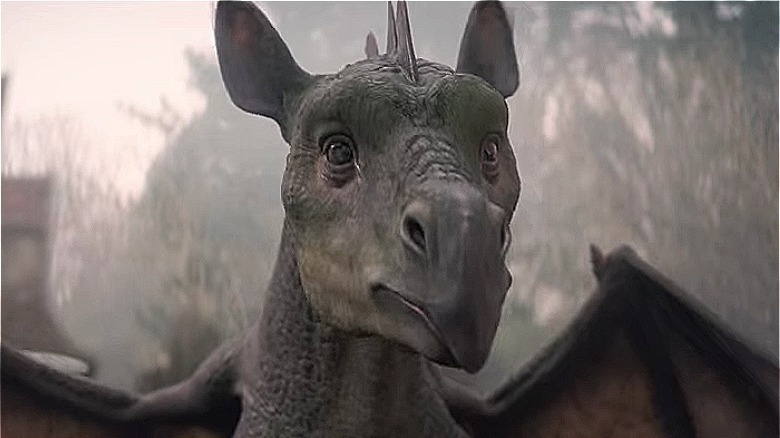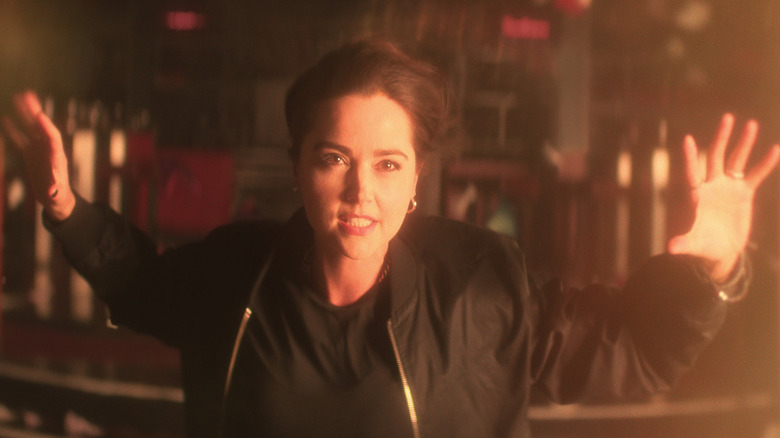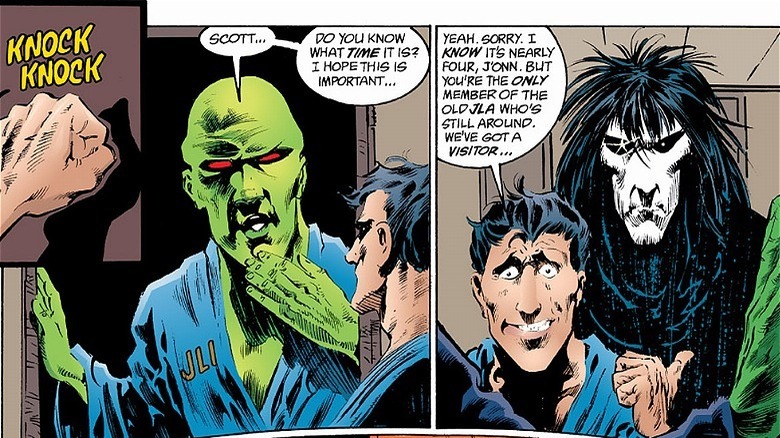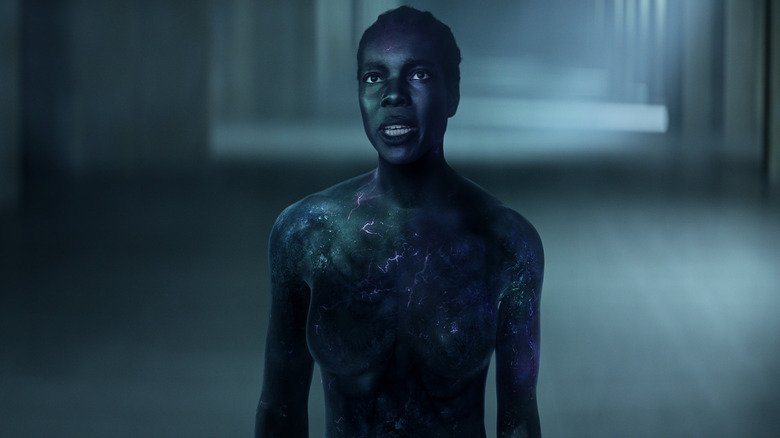The Biggest Differences Between Netflix's The Sandman And The Comic Books
Neil Gaiman fans have been eagerly awaiting the release of Netflix's "The Sandman," and their patience has finally been rewarded. Season 1 of the dark fantasy saga has everything that the franchise's audience could dream of and much more. With a certified fresh rating on Rotten Tomatoes, it's clear that Netflix has a winner on their hands.
The series was adapted from "Sandman" DC comics published between 1989 and 1996. "The Sandman" tells the story of Dream (Tom Sturridge) of the Endless, also called Morpheus, ruler of the domain known as the Dreaming. Morpheus is the creator of both dreams and nightmares that appear in the unconscious minds of humanity. He is one of seven siblings known as the Endless, and his family also includes Death (Kirby Howell-Baptiste), Desire (Mason Alexander Park), Despair (Donna Preston), Destiny, Delirium, and Destruction.
The original run of "Sandman" comics received many awards, including the World Fantasy Award and several Eisner Awards. The series is highly regarded as one of the best graphic novels ever written, so it was only a matter of time before the stories of Dream and the Endless made it to the screen. Yet, as with any book-to-screen adaptation, there were some changes made in order to translate the comics into episodic TV. For those who may be curious about what changed between the comics and Netflix show and don't have time to read the comics (though we highly recommend doing so), we've compiled a list just for you.
The Netflix series left out the events of The Sandman: Overture
Episode 1 of "The Sandman" is "Sleep of the Just," in which we are introduced to Dream and his kingdom, the Dreaming. The Dreaming is where all nightmares and dreams make their home, and where mortals visit when they sleep. When we first meet Dream, he is on a mission to recover the Corinthian (Boyd Holbrook), a nightmare who escaped the Dreaming and has been committing gruesome murders in the land of the living. Armed with his magical tools, Dream hunts down the Corinthian only to be pulled away by dark magic and held prisoner for 100 years.
The Netflix show provides a simple and sensible motive for Dream's journey into the mortal world which leads to his capture. However, the events that led up to his imprisonment in the comics are much more complex. In 2013, a prequel written by Neil Gaiman was released by Vertigo Comics, titled "The Sandman: Overture."
In this tale, Dream is called to investigate a madness that has taken over the universe and threatens to destroy it. During his journey, he befriends a young girl named Hope and a mysterious cat who claims to be another version of Dream. His efforts are unfruitful as he fails to save the universe from destruction, and so Dream takes the last remaining living beings and creates a new reality. Once the new reality has been formed, Dream finds that his powers are nearly depleted. When he attempts to return home, his weakened state allows him to be captured, and this is where the original story of "Sandman" begins.
"The Sandman: Overture" is a fascinating story that explains a bit of Dream's history, but it might have been a little too much to insert into the Netflix series. But who knows? If all goes well, we might see "Overture" unfold in a future episode.
The series further explores Alex and Roderick Burgess
Netflix's "The Sandman" begins when Dream is held captive by a powerful practitioner of the dark arts named Roderick Burgess (Charles Dance). For about 100 years, Dream waits in silence, biding his time inside his prison of glass protected by magical wards. Roderick reveals that he did not intend to summon Dream, but his sister, Death. Upon his failure to capture Death, Roderick offers a proposal to Dream to grant him his freedom in return for a boon.
There are some key differences between the characters of Roderick and Alex Burgess in the comic books and in the Netflix adaptation. In the comics, Roderick's intentions for capturing Death were motivated by naked ambition; he hopes to gain power and immortality. After Dream refuses to give in to his demands and Roderick dies, his son Alex seeks these same benefits, and Dream refuses him, as well.
The motives of these characters were changed for the Netflix version. For instance, Roderick's reason for trying to capture Death in the show is so that he can bring back his son Randall, who died in World War I. Meanwhile, Roderick's younger son, Alex (played by Benjamin Evan Ainsworth and Laurie Kynaston) struggles to live up to his father's expectations. On multiple occasions, Roderick makes it very clear that he considers Alex a failure, and all Alex wants is his father's love and approval.
After Roderick's death, Alex offers to free Dream in exchange for a promise that he will not seek revenge against Alex or his romantic partner Paul (Gus Gordon and Christopher Colquhoun). Yet, filled with the need for vengeance, Dream does not take Alex's offer. Like the comic books, in the end, Dream curses an elderly Alex with ever-lasting nightmares from which he will never wake.
Ethel wasn't originally alone in her betrayal
Along with Roderick and Alex Burgess, Netflix's "The Sandman" also takes a more in depth look at another character from the comics, Ethel Cripps. The 20-something Ethel (Niamh Walsh) is introduced when she helps Alex calm an angry mob on his doorstep, charming him in the process. She later makes her way to becoming Roderick's mistress and becomes pregnant with his child. Angered by this news, Roderick demands that Ethel get an abortion, but she refuses. Instead, Ethel steals Roderick's most prized possessions — the tools he stole from Dream — and makes a run for it.
The second episode of "The Sandman," titled "Imperfect Hosts," reveals that a seemingly middle-aged Ethel (Joely Richardson) has become a successful thief. She has been granted immortality by a magical talisman she obtained by trading Dream's helm to a demon. She also sold off the bag of sand and her son John took the powerful ruby necklace.
Ethel Cripps was originally a character in DC comics long before Neil Gaiman's "Sandman," and appeared in a minor role in the original run of the graphic novel. What the Netflix series cut out of Ethel's story is that she did not pilfer Dream's tools on her own. Roderick's trusted right hand is a man named Ruthven Sykes (played by Ansu Kabia in the show). In the comics, Sykes betrays Roderick and he and Ethel run off together, living as lovers for a time. Ethel eventually betrays Sykes, stealing the magical items and the protective talisman, which leads to Sykes' death.
Lucien became Lucienne
After escaping his century-long captivity in London, Dream returns to his kingdom to find it in ruin. Though many of his subjects have abandoned the Dreaming, a few still remain. One of them is his loyal librarian, Lucienne (Vivienne Acheampong), who is the first to greet Dream and inform him of the dire conditions that arose in his absence.
Lucienne is more than just a stuffy purveyor of tomes. She has been the one running the show while Dream was locked up, and she likes to take charge behind the scenes, much to Dream's chagrin. As the old saying goes, behind every great man is a great woman, and Lucienne is no exception. However, those who have not read the comics version of "Sandman" might be interested to know that the original character was not Lucienne, but Lucien.
There are very few differences between the original Lucien of the comics and Lucienne of the Netflix show. The one major change, of course, is that Lucien is male, and Lucienne is female. Both characters wear glasses and old-fashioned suits, have pointed ears, and are exceptionally loyal to Morpheus. So really, when it comes down to it, Lucienne is a mostly faithful iteration of Lucien of the comic books, with just two extra letters added to the name.
The fate of Gregory
Though he only makes a brief appearance in Episode 2 of "The Sandman," Gregory the Gargoyle quickly became a fan favorite for viewers of the Netflix series. With his puppy dog eyes and affectionate disposition, it's no wonder that the playful gargoyle was so beloved by brothers Cain (Sanjeev Bhaskar) and Abel (Asim Chaudhry) — and by the fans, of course. Unfortunately, with Dream's powers nearly depleted, there is only way one for him to regain his strength. Much to the dismay of Abel and Cain, Gregory willingly gives up his life so that the king of dreams can restore the Dreaming to its full glory. Gregory's sacrifice was a heart-wrenching ordeal that deeply affected many viewers and inspired the #JusticeForGregory hashtag on Twitter.
In the comics, Gregory doesn't get quite the same amount of the spotlight, but at least he survives the events of "Imperfect Hosts." Gregory is first introduced officially in the DC horror series "House of Mystery," and Neil Gaiman put him in issue #2 of "Sandman." When Dream returns to his domain in a weakened state, the helpful gargoyle carries him to Cain and Abel. We are glad that this favorite mythical creature found new life and got internet famous through the Netflix show, though we had to say goodbye far too soon. At least we still have Goldie (or "Irving," in our hearts) to fawn over.
Johanna Constantine replaced John Constantine
Episode 3 of "The Sandman" introduces Johanna Constantine (Jenna Coleman), an expert demon hunter and professional exorcist. Dream tracks down Johanna to find his pouch of sand after the Fates tell him that she was the last to purchase it. Unfortunately, Johanna no longer has the pouch, as she left it behind when she quietly fled the apartment of her ex-girlfriend Rachel (Eleanor Fanyinka). Dream and Johanna find Rachel in the flat she once shared with Johanna, and sadly, Rachel's addiction to the sand's magic has caused her to physically and mentally waste away.
Unpacking the difference between Johanna Constantine in the Netflix show and John Constantine in the comic books is a bit of a trek, so bear with us. Firstly, it must be noted that this is not a gender swap, but a full character change. In the comics, it is John Constantine who teams up with Dream at this point in the story. John is the descendant of Johanna Constantine, who also dabbles in the supernatural during the 17th and 18th centuries. She also makes an appearance in Episode 6, "The Sound of Her Wings," and is played by Jenna Coleman, just like her kinfolk seen in Episode 3. Technically speaking, the modern Johanna is an original character in the Netflix series, replacing John altogether.
So why did Netflix change John to Johanna? It's a little complicated, but one reason may be that existing DC television and film versions of John Constantine might have caused a bit of confusion with "The Sandman" universe. Neil Gaiman and executive producer Allan Heinberg have discussed the change pretty extensively in various chats with the media.
John Dee in the comics is a well-known DC villain
One of the most impactful stories from both the "Sandman" comic and the Netflix show is "24/7," in which John Dee (David Thewlis), the son of Ethel Cripps and Roderick Burgess, uses the magic ruby to terrorize the occupants of a small-town diner. Determined to make the world a better place through unflinching honesty, John manipulates the ruby to force innocent people to give in to their darkest instincts. A conflict between John and Dream ensues, ending with the ruby destroyed and John returning to the mental hospital in a deep sleep.
While John Dee is a well-fleshed-out character in the Netflix show, some fans may not realize that he has a much wider role in the comic book universe. In fact, the original John Dee is none other than Doctor Destiny, one of the great DC villains who has gone up against the Justice League in various adventures. In the comic books, Doctor Destiny is a mad scientist who creates dastardly inventions meant to destroy the JLA. His ruby is called the Materioptikon, which allows him to control people's dreams and was later retconned as one of Dream's tools. Dee first appears in "Justice League of America" in 1961 and shows up in "Sandman" in 1989.
When we first meet John Dee in "Sandman" comics, he is imprisoned in Arkham Asylum. After being defeated by Dream, he returns to the facility once more, pitiful and powerless, pretty much like in the Netflix series. While John Dee was rewritten in a more practical role for the show, it's still interesting to know where he came from.
Netflix omits key Justice League members
John Dee isn't the only DC Comics character to appear in the original "Sandman." With such a big universe to play with, how could Gaiman resist putting other established heroes and villains into his work? Though they were left out of the Netflix adaptation, there are two other DC superheroes who have walk-on roles in the "Sandman" comics.
After Dream recovers his bag of sand and his helm, he begins the journey to find his prized ruby. However, it's a bit more difficult than the previous two endeavors. So, Dream enlists the help of Scott Free, aka Mister Miracle, to help find the ruby. Created by the legendary Jack Kirby, Mister Miracle had his own comic book series beginning in 1971 and eventually becomes a member of the Justice League of America. Unfortunately, Scott has no clue where the ruby is, but he knows someone who might.
Dream and Scott visit the home of another JLA member – Martian Manhunter, also called J'onn J'onzz. One of Dream's attributes as one of the Endless is that he appears in different forms depending on who sees him. To J'onn, Dream looks like a giant black skull wreathed in flame. J'onn calls him Lord L'zoril with seeming familiarity and regards him as a god. J'onn then directs Dream to where he can find the ruby, and the Endless goes on his way. It's only a small cameo from the two JLA members, but it establishes Dream and the Endless as a new expansion of the DC Universe.
Gault is an original character in the Netflix series
Netflix's "The Sandman" brings to life some of our favorite characters from the comic books, from the lovable Matthew the Raven (Patton Oswalt) to the unsettling Corinthian. Yet the show also introduces new characters to the world of Dream and the Endless and loses others in the process.
Episode 6 of "The Sandman," titled "The Doll House," introduces Rose Walker (Vanesu Samunyai), a young woman searching for her younger brother Jed (Eddie Karanja). Jed, meanwhile, is in a foster home where he suffers abuse from his cruel caretaker Barnaby (Sam Hazeldine). To escape the hardships of the waking world, Jed finds solace in his dreams where he is an intrepid superhero known as The Sandman. Little does the boy know that the being who resembles his mother in his dreams is actually Gault (Ann Ogbomo), an escaped nightmare from the Dreaming.
Gault is a new character written for the Netflix show who longs to become a dream instead of a nightmare. Gault replaces Brute and Glob from the comics, whose motives for hiding away in Jed's dreams are much more malicious. Instead of helping Jed, the duo hope to create their own version of the Dreaming that they will rule. Of course, they are eventually caught by Dream who puts an end to their antics and their existence.
Lyta's journey was changed significantly for the show
During the process of adapting "Sandman" from the page to the screen, many aspects of the story underwent varying degrees of transition. Possibly the most drastic change came with the character of Lyta Hall (Razane Jammal). In the Netflix show, Lyta is a dear friend to Rose Walker and accompanies her to London where they learn about Rose's great-grandmother, Unity Kincaid (Sandra James-Young). She also travels with Rose to Florida where they stay in a B&B filled with colorful characters.
Lyta has been in mourning for years following the death of her husband, Hector (Lloyd Everitt). She manages to find him in her dreams, where the two make a home for themselves and Hector begs Lyta to stay. However, thanks to the instability of the Dreaming, Lyta's dreams bleed into her waking life and she becomes pregnant with Hector's child. When Dream finds them in Lyta's dream, he sends Hector away, breaking Lyta's heart in the process.
As far as Lyta goes, "The Sandman" show differs greatly from the original comics. In the comics, Lyta's husband Hector Hall takes on many superhero identities, including Silver Scarab, Doctor Fate, and even Sandman. As for Lyta, she was known as Fury, and was affiliated with the superhero group known as Infinity, Inc. In "The Sandman" issue titled "Doll's House Part 3," Lyta and Hector are both living within Jed's dream world, without any knowledge of where they truly are. They also fail to realize that Hector is actually dead, and Brute and Glob have taken his soul captive. Like Lyta in the show, Lyta in the comic is pregnant with Hector's child, and has been for several years.
It's possible that Netflix changed Lyta's story to cut off ties to the complex and convoluted DC superhero universe and avoid any unnecessary confusion. They couldn't leave her out altogether, however, as she plays an important role in Dream's future, as does her unborn child. Hopefully we'll have more seasons of "The Sandman" on Netflix to see those events come to fruition.

